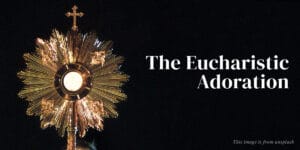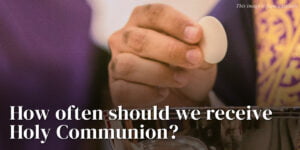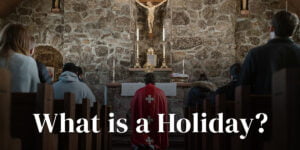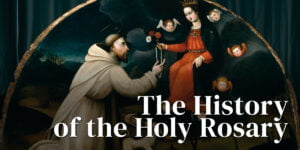I. The Early Holy Mass (33 A.D.)
A. The First Holy Mass: The Last Supper
The first Holy Mass in the world took place during the Last Supper of our Lord, where a paschal lamb, unleavened bread, and wine were present. Our Lord Jesus consecrated the unleavened bread as His body and the wine in the Chalice as His blood. This is the day when the Sacrament of the Holy Eucharist was instituted. Then He gave it to His disciples and commanded them to do this for a commemoration of Him.
B. The Apostolic Mass
The Apostles literally followed the command of our Lord by celebrating the Mass exactly as He did at the Last Supper, in a ritual and sacrificial meal. But, when Christianity spread in different places, the reproduction of the Holy Mass cause a problem where the faithful forgotten its original symbolism, where they ate selfishly the paschal lamb and get drunk as they saw the Mass as a Happy Meal. This is the first liturgical abuse of the Holy Mass in the world. These results were rebuked by St. Paul, the Apostle, in his letters to the Corinthians. To avoid further abuse, the first Pope, St. Peter, together with the apostles, reformed the Holy Mass where they removed the meal but retained the unleavened bread and wine with the consecration ritual. In this Holy Mass, the Psalm and Sanctus were sung, and the greeting of Dominus Vobiscum (The Lord be with you) was added. It was believed that facing the Altar instead of the people was started in the Apostolic Mass.
II. The Pre-Tridentine Mass
A. The Full Account of the Holy Mass
During the ministry of the Apostles and their disciples, there is no complete account of the Holy Mass in the Sacred Scriptures. But when St. Justin Martyr defended Christianity, he preserved the full account of the Holy Mass. It includes offering of bread and wine to the priest, wine mixed with water, thanksgiving prayers, prayers ended with Amen, distribution of communion under both species to all present, the necessity of faith in the Catholic truths and Baptism in order to receive the Holy Eucharist, reading of memoirs of the Apostles or prophets and Kiss of peace. The Holy Mass’ contents were believed to be derived from St. Peter and the Apostles.
B. The 2nd and 6th Century
Before, Greek was the language used to celebrate the Holy Mass, even in Rome. Because most Christians at that time were Greeks. But over the years, Latin slowly became the language of the Holy Mass in Rome. And then many prayers and activities were added during the 2nd to 6th centuries, such as the sacrificial prayer after consecration and Kyrie Eleison. Then the Holy Mass was divided into two parts, the Mass of the Catechumens and the Mass of the Faithful. And the first reform of the Holy Mass under Pope St. Gregory the Great, but according to the Sacred Tradition. He included the Gregorian Chant as well.
C. The 7th Century
In the 7th century, the Papal Mass was instituted, where its celebration is more special than the ordinary Mass.
D. During the Frankish Empire
There are two prayers added to the Holy Mass: Suscipe Sancta Trinitas (Accept, Holy Trinity) and Orate Frates (Pray Brethren). Altar Rails are installed by the church to separate the faithful from the altar. The faithful also used it during Holy Communion.
The Sacred Host is the body of Christ, and every crumbs even the small ones are still part of it.
In previous centuries, it was difficult for the celebrant to keep a small crumb from being scattered. During the Frankish Empire, a pure white waffle made of unleavened bread was created to reduce crumbs and was mandated to be served in all churches.
E. Gothic Period
During the Gothic Period, hiding the Paten under the Corporal was added, which symbolises when Christ hides His Divinity while here on Earth. And during the Consecration, the Sacred Host and Chalice are elevated higher so that the faithful can see and adore them.
III. The Tridentine Mass
Before and during the Protestant Reformation, every church and even Religious Orders had their own version of the Holy Mass, but still followed the Sacred Tradition. At that time, there was a lack of religious practice among the clergy, major and minor orders, and also the faithful. The protest is aimed at this individual to have a discussion about Christian faith and the Bible. And because of mistranslations used in the Catechism and in the Holy Mass, Protestants also find ways to attack Catholics. That is why Pope Paul III started the Council of Trent to initiate a counter-reformation. At the end of the Council of Trent, the plans were not yet executed. Until Pope St. Pius V became the Pope and executed the council’s plan. He reforms the Church, but still according to Sacred Tradition. One of his reforms is codifying the Tridentine Mass, which we now know as the Traditional Latin Mass. He made the Mass in Latin and it must be celebrated in all churches worldwide, with no other version to be used. After codification, the Holy Mass was no longer reformable.
Then in 1962, Pope John XXIII made some changes, including the addition of St. Joseph’s name to the Holy Mass.
IV. The Novus Ordo Mass (New Order of Mass)
In 1969, Pope Paul VI reformed the Holy Mass to adapt it to modern times and appeal to Protestants. He gave Archbishop Annibale Bugnini the responsibility of reforming the Mass with assistance from six protestants. Major changes have occurred in this Mass. The Priest is now facing the people, the Latin language was changed to vernacular language, Gregorian Chant was replaced by modern music and prayers were reduced in favor of the protestants such as reducing the repeated prayers. Following this Mass, there were many liturgical violations, such as Liturgical Dances and Communion in the Hand.
V. The Extraordinary form of the Mass
In 2007, Pope Benedict XVI allowed the use of the Tridentine Mass or the 1962 Roman Missal under the name of “Extraordinary form of the Mass” where the Clergy can now celebrate it without Papal approval or any approval for the superiors. In the previous years, only a few Catholic Societies, such as the Society of St. Pius X (SSPX) and Fraternity of St. Peter, can celebrate the traditional Mass. But when Pope Benedict XVI allowed its use again, many clergy tried to celebrate it, which gave birth to more traditional Catholic societies.
Source: https://fsspx.asia/en/news-events/news/brief-history-roman-mass-8081





